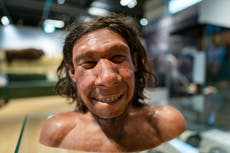Neanderthals might have lived as ‘different human form’ instead of separate species, scientists say
‘We demonstrate that there is no doubt that Neanderthals could make a fire’
Neanderthals were much more intelligent than previously thought and were skilled enough to control fire and use it to cook food, according to a new study which suggests they lived closer to a “different human form” rather than be a separate species.
The research, published in the journal PLOS One, suggests Neanderthals were capable of symbolic thought, could create artistic objects, knew how to decorate their bodies using personal ornaments and had an extremely varied diet.
Scientists, including Alessandra Saletti from Università di Trento in Italy said Neanderthals may have habitually also eaten cooked food, suggesting they were likely as skilled as early sapiens who lived millennia later.
“In this study we demonstrate that there is no doubt that Neanderthals could make a fire and that fire was a central element in their daily life,” study co-author Diego Angelucci said.
The research documented and compared the remains of structured fires found in the Gruta de Oliveira in central Portugal – one of the most important European archaeological sites for the Middle Palaeolithic.
This cave is part of the Almonda karst system – a vast network of caves placed at different elevations above a large spring inhabited in different periods of prehistory.
Its oldest layers include a number of passages dating back to about 120,000 years ago and the most recent to about 40,000 with Neanderthals likely living in this place between 100,000 and 70,000 years ago.
Archaeologists found traces of about a dozen hearths intentionally built and used in the cave at various levels in an area of about 30 sq metres and 6m deep.
Findings suggest the inhabitants of the caves used to cook their food.
“We found burnt bones, burnt wood and ash remains. And the rock underneath has been reddened by the heat: this is a crucial detail because it tells us that the structure is in a primary position,” Dr Angelucci said.
“And it has always been there. Fire is a fundamental element in their daily lives. It makes the place comfortable and helps socialization. It gives back that basic idea of ‘home’ that perhaps could also apply to them,” he said.
Scientists found remains and burnt bones of cooked goats, deer, horses, aurochs (extinct bulls), rhinos and turtles, which were probably laid on their carapace and stewed on hot stones in the cave.
However, they are unsure how the Neanderthals started a fire.
“Perhaps they did as in Neolithic times, striking flint rocks against another rock to throw sparks on a tinder, such as a dry nest for example. This is a prehistoric technique that was discovered by studying Ötzi, the Ice man. So far however, we have found no evidence of this,” researchers said.
Then by excavating layers covering about 30,000 years, archaeologists compared the data with other sites in the same area dating back to a more recent period when Homo sapiens were confirmed in the area.
“We found no difference: they lived in the caves in similar ways. Their skills are also a sign of intelligence,” said Diego Angelucci, one of the study’s authors.
“They did not belong to different species, I would say that they were different human forms.”
Join our commenting forum
Join thought-provoking conversations, follow other Independent readers and see their replies
Comments


Bookmark popover
Removed from bookmarks